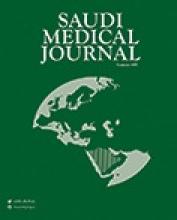Abstract
OBJECTIVE: To elucidate blood pressure (BP) levels and the prevalence of hypertension (HT); as well as to address some epidemiological variables which contributes to BP and suggest certain primordial guidelines for control and prevention of childhood HT.
METHODS: A cross-sectional study recruiting 1427 (46.1% boys versus 53.9% girls) school aged students (6-12 years) from 8 primary schools in Baghdad during the period November 2001 to May 2002. The BP readings were plotted adopting principles of the 1996 American Task Force on High Blood Pressure in Children and Adolescents.
RESULTS: For both genders, the combined mean systolic blood pressure (SBP) was 106.66 ± 9.03 mm Hg and combined mean diastolic blood pressure (DBP) was 67.09 ± 7.98 mm Hg. There was no significant statistical differences noted with respect to SBP and DBP among boys and girls except at the age range of 10-12 years, where girls manifest higher SBP (p<0.01) and DBP (p<0.05) than boys. Obesity was reported in 7.3% of sample with significant girl's preponderance (3.2% for boys versus 4.1% for girls, p<0.05). Hypertension was recorded 1.8 fold higher among obese (4.7%) than non-obese children (2.6%) (p<0.05). Multiple regression analysis showed positive and significant correlation of age, weight, height and body mass index with each SBP and DBP. The overall prevalence of HT was 1.7% with significantly higher systolic HT (1.1%) than diastolic HT (0.6%) (p<0.05) but with no significant gender distribution (0.8% for boys versus 0.9% for girls). For both genders in the hypertensive group, the mean SBP was 127.66 ± 5.46 mm Hg and DBP was 77.26 ± 6.19 mm Hg.
CONCLUSION: Despite the low prevalence of our childhood HT (1.7%) compared to some Arabian and foreign countries, careful approach to the problem deems crucial through routine recording of BP and constructing our own national nomograms, age, gender and height specific, inspired from our nutritional, cultural, ethnic and social backgrounds. Moreover, implementing school heart health curriculum seems tentative to interrupt or ameliorate progression of HT as our children enter adulthood.
- Copyright: © Saudi Medical Journal
This is an open-access article distributed under the terms of the Creative Commons Attribution-Noncommercial License (CC BY-NC), which permits unrestricted use, distribution, and reproduction in any medium, provided the original work is properly cited.






